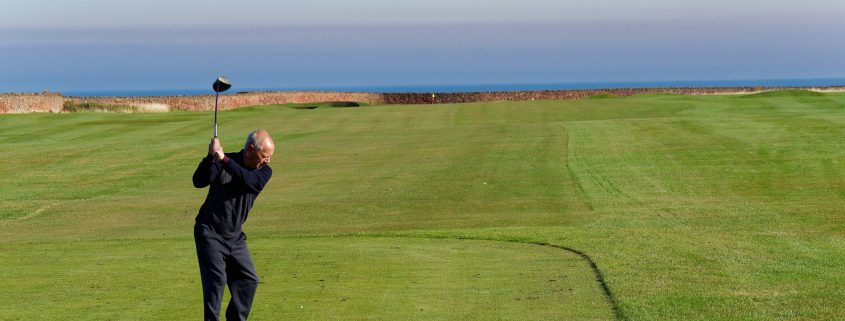Don’t let aches and pains ruin your golf season
Spring is finally here, which means golf season is right around the corner!
And there is nothing worse than an injury or chronic pain getting in the way of you enjoying your favorite sport.
At our office, we see a lot of chronic golf injuries — especially from folks in their 50’s and 60’s. That’s why I want to share with you some of my top tips for avoiding and preventing these common aches and pains so that you can stay out of the doctor’s office and keep doing what you love most… golf!
1. Strengthen your upper back and shoulders
Do you have tendonitis in your wrists and elbows? It could be from weakness in your upper back and shoulders. This is a common oversight that I see in my office all the time. Everyone is focused on their swing, but they neglect to consider whether or not they have the proper strength to hold the form. When it comes to preventing elbow and wrist injuries, you must have adequate strength in your upper back. I call this area the “mini-core” of the upper body, and it’s where a lot of your power comes from. If you’re suffering from chronic elbow and wrist problems no matter how many times you’ve iced or rested the affected area, you should see a physical therapist to assess your upper back and shoulder strength. That could be the true root of your problem.
2. Mobility before Stability
If you’ve ever been in my office, you hear me say this all the time. Before you attempt to strengthen a move – let’s say it’s your swing- you must have adequate mobility. The last thing you want to do is strengthen, or reinforce, a stiff and inefficient movement-pattern. For example, let’s say you’re having back or hip pain that’s impacting your swing. If all you do is stretch or foam roll those “tight” muscles, you’re simply putting a bandaid on the problem. Instead, you should be examining the specific joint. How well do the vertebrae in your spine bend and rotate? How much mobility do you have through your hip? Once you address your joint mobility, your muscles will be able to work better as they experience less stress and tension. Not sure how to improve your mobility, or wondering if it’s even a problem? Just ask a mobility expert, like the specialists in our office.
3. Don’t sit too much
What you do off the course is just as important as what you do on the course. A big problem I see, especially as clients get into their 50’s and 60’s, is that our bodies need a little more time to prep and acclimate before activities — especially repetitive ones like golf. If you have a desk job and sit most of your day, be mindful of what all that sitting does to your muscles and ligaments. Over time, something called “creep” can occur, which results in your muscles getting chronically over-stretched from too much sitting. It’s like an elastic that lost all its stretch. This phenomenon puts your muscles in a weakened position, and it’s how people end up straining a muscle for what seems like “no reason.” One simple and easy tip to avoid straining your back or hamstring next time you’re out on the golf course is to make sure you interrupt your sitting with a brief period of movement at least once every 30 minutes throughout the day.
4. Work on your core
I know I’m not the first to tell you that strengthening your core not only helps your golf game, but helps to prevent neck and back pain as well. Why? When you strengthen your core the right way, you not only get strong abs and glutes, but you become more coordinated and improve your reaction time. This is essential if you want to perfect your golf swing! When your limbs need to move together in one coordinated effort, like hitting a golf ball, that power comes from your core. Otherwise, you end up with sloppy moving limbs, or worse — repetitive strain injuries because your arms and legs end up working harder than they need to in order to compensate for a weak core.
But what’s the best way to properly strengthen your core?
At CJPT, we love Pilates. It’s a full body strengthening system that also challenges your mind. You have to concentrate on each exercise, which not only improves your coordination, but your timing and rhythm as well — all of which are required for a perfect swing. Plus, Pilates is easy on your joints. In fact, doing Pilates with springs like we have in our office can even help with arthritis!
5. Walk!
This might seem like an odd tip, but walking helps to keep all of your joints loose and lubricated in addition to improving your endurance on the golf course. It’s a vicious cycle — you take the cart because walking hurts your knees, but you need to walk to help your knees. My suggestion is to walk regularly when you’re not golfing to help keep your endurance and mobility when golf season rolls around. Currently suffering from knee pain? Get yourself a good pair of shoes and start slow. Aim for a 5 min walk to start and when that gets comfortable increase it 5 more minutes. Make small changes throughout the day, like parking farther away to make yourself move a little bit more. And if after these changes your knees still hurt and are keeping you from walking, get them checked out! My tip is to choose a physical therapist if you want to avoid injections, pills or surgeries.
Curious about how physical therapy and/or Pilates could help you stay healthy and strong through this golf season? Check out our programs and offerings here!
All of us at CJPT & Pilates wish you many injury-free rounds this season!




